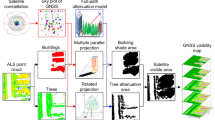Abstract
Satellite coverage is one of the most important elements of satellite applications, which determines the range and duration of the service provided by the satellite. We propose a rapid one-dimensional method to predict when a ground target is visible from the satellite, which means the ground target is within the footprint of the satellite, for an arbitrary sensor field. The field is defined as the shape of the observable range of the sensor placed on the satellite. For instance, the cone field means the shape of the observable range of the sensor is a circle, while the rectangle field means the shape of the observable range of the sensor is a rectangle. First, the minimum-observation function is defined to describe the geometric properties of the sensor field of a satellite. Based on the geometric relationship between the satellite and a target, visible conditions at a ground point given the satellite field of view are obtained, considering the field and earth-occlusion constraints. In order to calculate the visible set during a given period, the Hermite cubic interpolation method is used to obtain the earth-occlusion-off intervals rapidly, and the field-constraint function is fitted by the linear fixed-step method. The visible intervals of the ground point from the sensor are obtained by finding the zero points of the fitting field-constraint function limited by the earth-occlusion-off intervals. To demonstrate the effectiveness of the proposed method, a series of numerical simulations are conducted. The simulation results indicate that the proposed method can balance computation time and precision, which is suitable for various types of satellite orbits and sensor fields. Thus, as a practical method, the proposed method can provide efficient communication, navigation, and remote sensing tool.

































Similar content being viewed by others
Abbreviations
- ECEF:
-
Earth-centered earth-fixed
- ECI:
-
Earth-centered inertial
- SBF:
-
Sensor-body-fixed
- STK:
-
Satellite Tool Kit
- UVFV:
-
Unit vector of the field of view
- VVLH:
-
Vehicle vertical local horizontal
References
Alfano S, Negron D, Moore JL (1992) Rapid determination of satellite visibility periods. J Astronaut Sci 40:17
Ali I, Al-Dhahir N, Hershey JE (1999) Predicting the visibility of LEO satellites. IEEE Trans Aerospace Electr Syst 35:1183–1190
Chen X, Reinelt G, Dai G, Spitz A (2019) A mixed integer linear programming model for multi-satellite scheduling. Eur J Oper Res 275:694–707
Chen X, Song Z, Dai G, Wang M, Ortore E, Circi C (2021) A general formal method for manifold coverage analysis of satellite constellations. IEEE Trans Aerospace Electr Syst (Paper 3123236).
Cinelli M, Ortore E, Laneve G, Circi C (2021) Geometrical approach for an optimal inter-satellite visibility. Astrodynamics 1–12
Dai G, Chen X, Wang M, Fernández E, Nguyen TN, Reinelt G (2017) Analysis of satellite constellations for the continuous coverage of ground regions. J Spacecraft Rockets 54:1294–1303
Han C, Gao X, Sun X (2017) Rapid satellite-to-site visibility determination based on self-adaptive interpolation technique. Sci China Technol Sci 60:264–270
Han C, Yang P, Wang X, Liu S (2018) A fast computation method for the satellite-to-site visibility. In: 2018 IEEE congress on evolutionary computation (CEC), Rio de Janeiro, July 8–13, pp 1–8
Han C, Bai S, Zhang S, Wang X, Wang X (2019) Visibility optimization of satellite constellations using a hybrid method. Acta Astronaut 163:250–263
Huang S, Colombo C, Bernelli-Zazzera F (2021) Multi-criteria design of continuous global coverage Walker and Street-of-Coverage constellations through property assessment. Acta Astronaut 188:151–170
Jiang Y (2020) Ephemeris monitor with ambiguity resolution for CAT II/III GBAS GPS. Solut 24:116
Ma F, Zhang X, Li X, Cheng J, Guo F, Hu J, Pan L (2020) Hybrid constellation design using a genetic algorithm for a LEO-based navigation augmentation system. GPS Solut 24:1–14
Morrison JJ (1973) A system of sixteen synchronous satellites for worldwide navigation and surveillance. United States. Federal Aviation Administration
Mozo-García Á, Herráiz-Monseco E, Martín-Peiró AB, Romay-Merino MM (2001) Galileo constellation design. GPS Solut 4:9–15
She Y, Li S, Zhao Y (2018) Onboard mission planning for agile satellite using modified mixed-integer linear programming. Aerosp Sci Technol 72:204–216
Song Z, Dai G, Wang M, Chen X (2018) A novel grid point approach for efficiently solving the constellation-to-ground regional coverage problem. IEEE Access 6:44445–44458
Stoer J, Bulirsch R (1993) Introduction to numerical analysis. Springer, New York
Sun X, Cui H, Han C, Tang G (2012) APCHI technique for rapidly and accurately predicting multi-restriction satellite visibility. In: Proceedings of twenty-second AAS/AIAA Space Flight Mechanics Meeting, Charleston, South Carolina, January, (Paper AAS-12-253)
Ulybyshev Y (2014) Geometric analysis and design method for discontinuous coverage satellite constellations. J Guid Control Dyn 37:549–557
Valicka CG, Garcia D, Staid A, Watson J, Hackebeil G, Rathinam S, Ntaimo L (2019) Mixed-integer programming models for optimal constellation scheduling given cloud cover uncertainty. Eur J Oper Res 275:431–445
Wang H, Han C, Sun X (2019a) Analytical field-of-regard representation for rapid and accurate prediction of agile satellite imaging opportunities. J Astronom Telescopes Instrum Syst 5 (Paper 037001).
Wang S, Zhao L, Cheng J, Zhou J, Wang Y (2019b) Task scheduling and attitude planning for agile earth observation satellite with intensive tasks. Aerosp Sci Technol 90:23–33
Zuo M, Dai G, Peng L, Wang M (2020) An envelope curve-based theory for the satellite coverage problems. Aerosp Sci Technol 100, (Paper 105750).
Acknowledgements
The authors thank Accdon (http://www.accdon.com) for the linguistic assistance in manuscript preparation.
Author information
Authors and Affiliations
Corresponding author
Additional information
Publisher's Note
Springer Nature remains neutral with regard to jurisdictional claims in published maps and institutional affiliations.
Rights and permissions
About this article
Cite this article
Bai, S., Zhang, Y. & Jiang, Y. Minimum-observation method for rapid and accurate satellite coverage prediction. GPS Solut 26, 110 (2022). https://doi.org/10.1007/s10291-022-01295-3
Received:
Accepted:
Published:
DOI: https://doi.org/10.1007/s10291-022-01295-3




